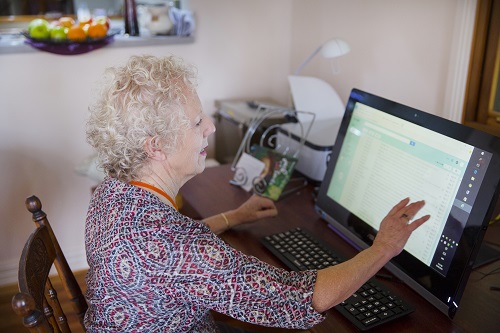By Ron Hooton
No matter who you are, there is no escaping the ever-growing role technology plays in our lives.
Whether it’s everyday tasks like banking or shopping, or the act of staying in touch with family and friends, it’s more and more likely technology in some form is what we turn to.
For many people this means convenience, but it’s important we don’t forget those who progress might leave behind.
Today, October 1, is the United Nations’ International Day of Older Persons. For Vision Australia, this year’s theme of “Digital Equity for All Ages” is extremely important.

Caption: More needs to be done to ensure older people have access to technology and are equipped with the skills to use it.
We know that as people age, incidence of blindness and low vision increases. Among the leading causes of blindness and low vision in Australia are conditions such as age-related macular degeneration, glaucoma and cataracts, and we predict there will be more than 500,000 people in Australia living with blindness and low vision by 2030.
What this means is that we need to have an emphasis now on ensuring our older people, and particularly those who live with blindness or low vision, have both equal access to and understanding of technology.
Access to technology
For thousands of people who are blind or have low vision across Australia, the National Disability Insurance Scheme (NDIS) supports them to access a wide range of technology they use in day to day life.
Unfortunately, people who develop a disability, such as blindness or low vision, after the age of 65 are deemed ineligible for the NDIS.
Unlike their younger counterparts, older Australians who are blind or have low vision receive little support to access the huge range of assistive technology that should be available to them.
Software that can magnify or read out what is on a computer screen, magnifiers to help people identify medication or other vital household items, large button phones; all of these can have massive benefit in the lives of older people who are blind or have low vision and they should be supported to access them.

Caption: The right technology can be life-changing for older people who are blind or have low vision.
Vision Australia is not alone in advocating for this support for older people with disability. Earlier this year, The Royal Commission into Aged Care Quality and Safety made a number of recommendations about the need for governments to do more to fund access to assistive technology.
The Royal Commission calls for those recommendations to be adopted by 2024. Our older population deserve assurances from the government these recommendations will be adopted to ensure they’re able to access the technology they need in the future.
Digital and tech literacy
While we need to ensure older people who are blind or have low vision are able to access the technology, it’s also vital they’re supported to learn how technology can support them.
Across Vision Australia we’re making a concerted effort to connect our older people with technology and make sure they understand how they can make the most of both mainstream and specialist technology.

Caption: Age or disability is often no barrier to using technology, including mainstream devices.
A particular focus of ours, given the impact of COVID-19, has been the potential for technology to support older people who are blind or have low vision to minimise social isolation.
Our Telelink and Quality Living Groups have long been a hugely effective way for us to connect our older clients with each other and our services. Rather than relying on telephones and face to face groups to deliver these, we’ve been exploring how technology like Zoom and Amazon Alexa can help us deliver these to more people.
We haven’t simply said to our older clients that this is what we’re doing though, we’ve brought them along with us and made sure we can upskill them in these technologies to allow them to continue to participate.
We’ve also explored through a hugely successful pilot program how smart devices like the Alexa can make it easier for more people to access our Vision Australia Library and its extensive catalogue of from books, newspapers, magazines and more.
While this work means it’s easier for our clients to access the range of services Vision Australia offers, it also benefits our clients in their day to day lives.
Familiarity and comfort with Zoom makes telehealth a more palatable option for older people and also opens up a new avenue for them to stay connected with friends and loved ones.
Being adept at using Alexa or other smart home devices means a whole world of information can be accessed by a simple spoken command.
We know the potential technology has to better the lives of older people who are blind or have low vision, but now it’s time for us to ensure we’re doing all we can to ensure our older people aren’t left behind.










